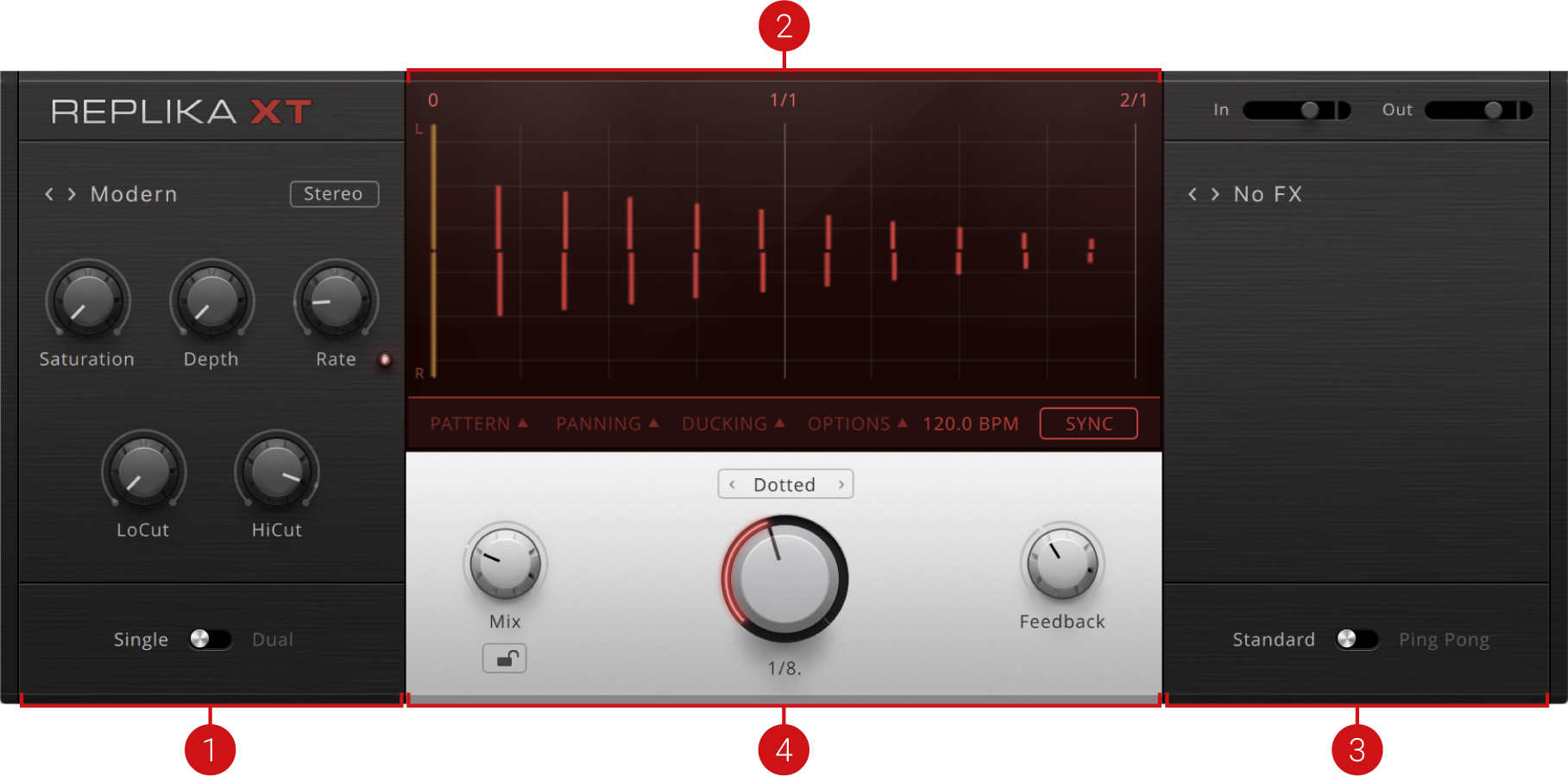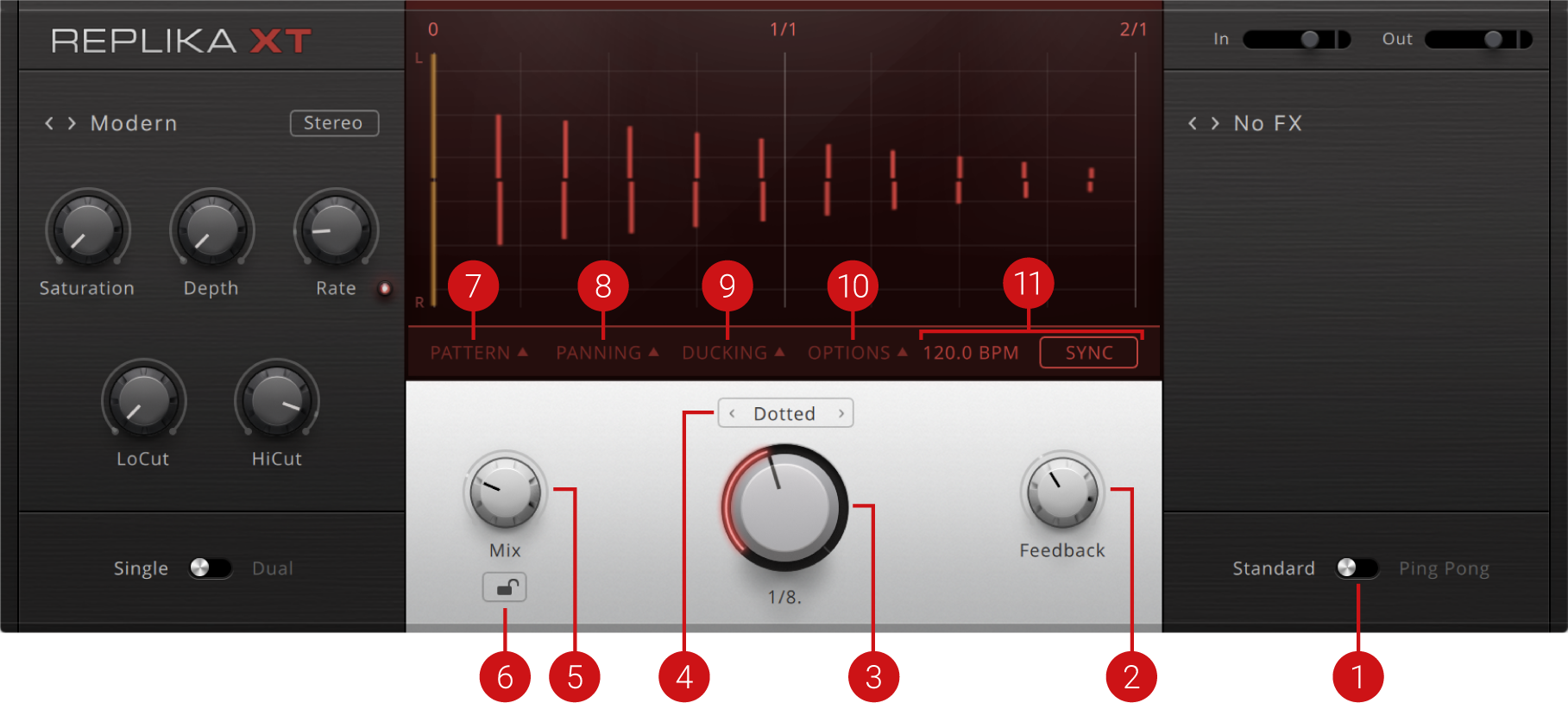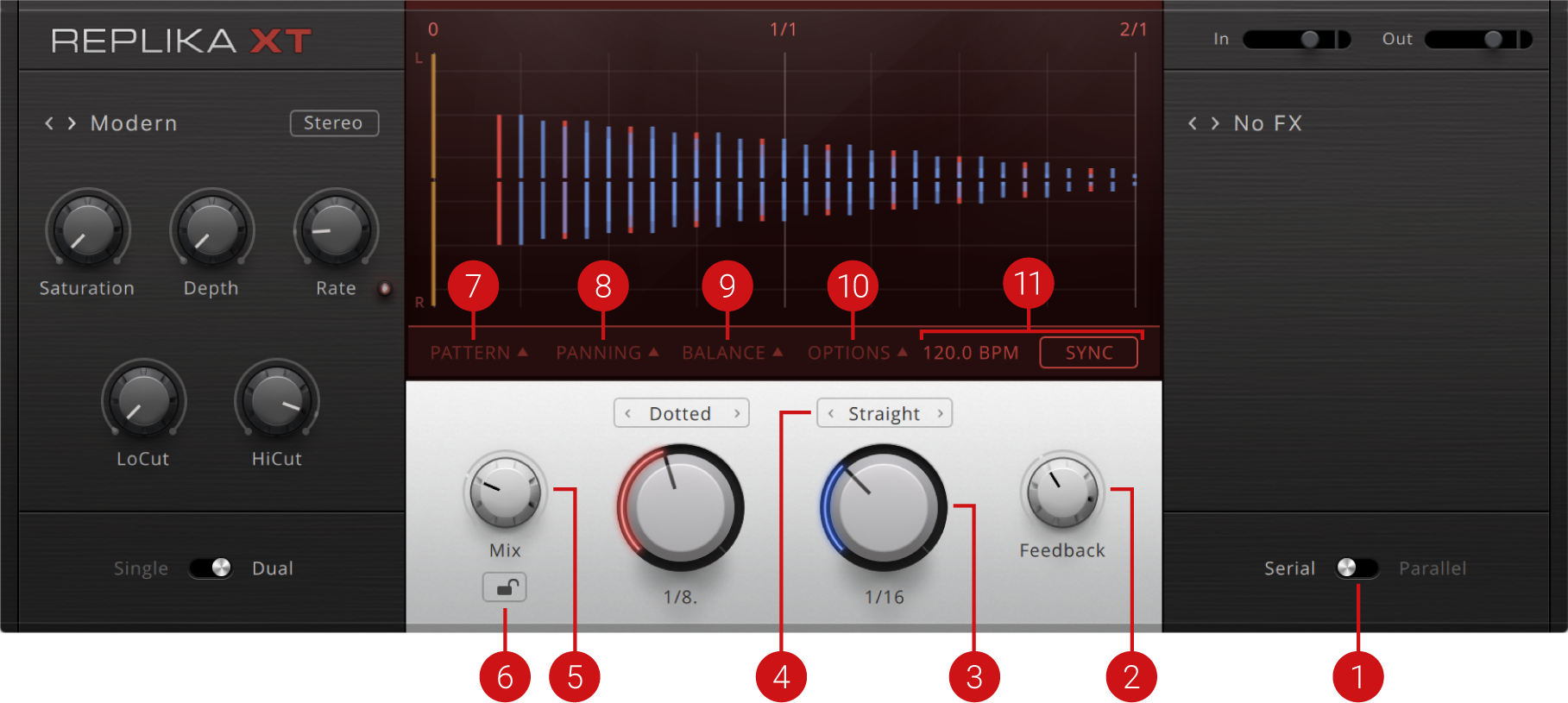Delay Section
REPLIKA XT's Delay section enables you to control the general aspects of your delay sound, including parameters like Delay Time, Feedback, and Mix.
The Delay section allows to you control the general aspects of your delay sound, including parameters like Delay Time, Feedback, and Mix.
More advanced settings are available in the menus at the bottom of the display. REPLIKA XT can be used as a single delay with Standard and Ping Pong options, or as a dual delay consisting of two delays A and B with Serial and Parallel connection options.

Single/Dual: Switches between REPLIKA XT’s Single and Dual modes. For more information about Single mode, refer to Single Mode. For more information about Dual mode, refer to Dual Mode.
Display and advanced settings: The Display provides dynamic feedback for your delay settings. It shows how the delay repeats of delay A (red) and delay B (blue) unfold over time and in relation to the input signal (yellow). At the bottom of the display you can find a number of menus with advanced delay settings.
Standard/Ping Pong, Serial/Parallel: Switches between the Standard and the Ping Pong options for Single mode, or the Serial and Parallel connection options for Dual mode, depending on the setting of the Single/Dual switch.
Main delay settings: Allows you to control the basic delay parameters, including Delay Time, Feedback, and Mix.
Single Mode
In Single mode, REPLIKA XT works as a single delay with true stereo input and output. This means that the stereo information in the input signal is preserved and passed through the delay. In the display you can see the repetitions of the delay in red.

Standard / Ping Pong: Switches between Standard delay and Ping Pong mode. When Standard is selected, REPLIKA XT works as a basic single stereo delay. When Ping Pong is selected, the delay repeats are panned hard left and right in an alternating pattern. Note that the stereo input is summed to mono in Ping Pong mode.
Note
Ping Pong mode requires additional delay lines to be calculated in the background, which increases the CPU load.
Feedback: Adjusts the level of the signal that is being fed back to the delay's input. Increasing the feedback level creates more delay repeats that decay over time. Feedback levels of 100% and above are possible, allowing the delay repeats to build up until the point of self-oscillation.
Time: Adjusts the delay time. Depending on the selected Time mode, the delay time is either synchronized to the tempo of the DAW and set in note divisions, or freely adjusted in milliseconds.
Note
The maximum delay time is 4000 ms, which can be achieved by settings a synchronized delay time of 2/1 at a tempo of 120 BPM. Slower tempos will limit the maximum delay time accordingly, which is reflected visually by the range of the Time control.
Time mode: Selects between four modes that determine the behavior of the Time control. You can select the mode by clicking on the left and right arrows next to the mode name, or show the TIME menu in the display by clicking on the mode name. The following modes are available:
ms: The delay time can bee freely adjusted in milliseconds.
Straight: The delay time can be adjusted in even note divisions (1/16, 1/8, 1/4, etc.) relative to the tempo of the Metronome.
Dotted: The delay time can be adjusted in dotted note divisions (1/16d, 1/8d, 1/4d, etc.) relative to the tempo of the Metronome.
Triplets: The delay time can be adjusted in triplet note divisions (1/16t, 1/8t, 1/4t, etc.) relative to the tempo of the Metronome.
Mix: Blends between the input signal and the effect signal by means of an equal-power crossfade.
Mix Lock: Locks the Mix control to the set value when switching presets.
Pattern: Opens a menu with settings for controlling the rhythmic feel of the delay. For more information, refer to section Pattern.
Panning: Opens a menu with settings for adjusting the stereo image of the delay. For more information, refer to section Panning.
Ducking: Opens a menu with settings for creating a ducking effect. For more information, refer to section Ducking.
Options: Opens a menu with settings for changing the delay routing. For more information, refer to section Options.
Tempo and Sync: Sets the tempo reference for the synchronized Time modes. When SYNC is activated, REPLIKA XT automatically follows the tempo of the DAW.
Pattern
The settings in the Pattern menu allow you to control the rhythmic feel of the delay repeats.

Shuffle: Adds a swing groove to the delay repeats by delaying the odd-numbered repeats more than the even-numbered repeats.
Feel: Adjusts the rhythmic feel of the delay repeats. Turning the control to the right produces a laid-back feel. Turning it to the left makes the repeats sit slightly before the beat for a rushed feel.
Accent: Adds a dynamic groove effect to the sound by emphasizing certain delay repeats. Turning the control to the right emphasizes odd-numbered repeats. Turning it to the left emphasizes even-numbered repeats.
Note
The functions in the Pattern menu require additional delay lines to be calculated in the background, which increases the CPU load.
Panning
The settings in the Pattern menu allow you to adjust the stereo image of the delay.

Pan Dry: Adjusts the panning of the input signal from left to right.
Pan Wet: Adjusts the panning of the delay signal from left to right.
Width: Adjusts the total width of the stereo image.
L/R Offset: Enhances the stereo image of the delay by adding a timing offset between the left and right channels.
Note
L/R OFFSET requires additional delay lines to be calculated in the background, which increases the CPU load.
Ducking
The settings in the Ducking menu allow you to add a ducking effect to the delay, which reduces the gain of the delay signal when the input level rises past a certain threshold.

Sensitivity: Adjusts the threshold at which the ducking effect sets in. Signal levels below this threshold will not trigger the ducking effect.
Amount: Adjusts the strength of the ducking effect, which is the amount of gain reduction applied to the delay signal when the ducking effect is triggered.
Release: Adjusts the release time of the ducking effect, which is the time it takes for the gain reduction to return to 0.
Reduction: Shows the amount of level reduction applied to the delay signal.
Options
The Options menu provides settings for changing the delay routing.

Routing mode: Switches between two routing modes. When DELAY → MOD is selected, only the delay signal is sent to the Modulation section. When DRY + DELAY → MOD is selected, both the input signal and the delay signal are sent to the Modulation section.
Ping Pong mode: Switches the order of the ping pong delay pattern. When PING PONG L/R is selected, the delay repeats start on the left channel and move to the right channel. When PING PONG R/L is selected, the order is reversed.
Dual Mode
In Dual mode, REPLIKA XT works as a dual delay with two delays A and B, which both offer true stereo input and output. This means that the stereo information in the input signal is preserved and passed through both of the delays. The delay times for the two delays can be set independently. In the display, you can see delay A in red and delay B in blue.

Serial/Parallel: Switches between Serial and Parallel routing options for the two delays. When Serial is selected, the input signal is sent to delay A, and the output of delay A is sent to delay B. The output of delay B is then passed on to the main output and the feedback loop. When Parallel is selected, the input signal is split and sent to both delay A and delay B. The mixed outputs of the two delays are then passed on to the main output and the feedback loop. The delay levels for the main output and the feedback loop can be set in the BALANCE menu (refer to Balance).
Feedback: Adjusts the level of the signal that is being fed back to the delay's input. Increasing the feedback level creates more delay repeats that decay over time. Feedback levels of 100% and above are possible, allowing the delay repeats to build up until the point of self-oscillation.
Time: Adjusts the delay time of delay A (red) and delay B (blue), respectively. Depending on the selected Time mode, the delay time is either synchronized to the tempo of the DAW and set in note divisions, or freely adjusted in milliseconds.
Note
The maximum delay time is 4000 ms, which can be achieved by settings a synchronized delay time of 2/1 at a tempo of 120 BPM. Slower tempos will limit the maximum delay time accordingly, which is reflected visually by the range of the Time control.
Time mode: Selects between four modes that determine the behavior of the Time control. You can select the mode by clicking on the left and right arrows next to the mode name, or show the TIME menu in the display by clicking on the mode name. The following modes are available:
ms: The delay time can bee freely adjusted in milliseconds.
Straight: The delay time can be adjusted in even note divisions (1/16, 1/8, 1/4, etc.) relative to the tempo of the Metronome.
Dotted: The delay time can be adjusted in dotted note divisions (1/16d, 1/8d, 1/4d, etc.) relative to the tempo of the Metronome.
Triplets: The delay time can be adjusted in triplet note divisions (1/16t, 1/8t, 1/4t, etc.) relative to the tempo of the Metronome.
Mix: Blends between the input signal and the effect signal by means of an equal-power crossfade.
Mix Lock: Locks the Mix control to the set value when switching presets.
Pattern: Opens a menu with settings for controlling the rhythmic feel of the delay. For more information, refer to section Pattern.
Panning: Opens a menu with settings for adjusting the stereo image of the delay. For more information, refer to section Panning.
Balance: Opens a menu with settings for mixing the two delays. For more information, refer to section Balance.
Options: Opens a menu with settings for changing the delay routing. For more information, refer to section Options.
Tempo and Sync: Sets the tempo reference for the synchronized Time modes. When SYNC is activated, REPLIKA XT automatically follows the tempo of the DAW.
Pattern
The settings in the Pattern menu allow you to control the rhythmic feel of the delay repeats.

A/B/LINK: Selects if SHUFFLE, FEEL, and ACCENT are set for delay A or delay B. When LINK is activated, delay A and delay B share the same settings in the PATTERN menu.
Shuffle: Adds a swing groove to the delay repeats by delaying the odd-numbered repeats more than the even-numbered repeats.
Feel: Adjusts the rhythmic feel of the delay repeats. Turning the control to the right produces a laid-back feel. Turning it to the left makes the repeats sit slightly before the beat for a rushed feel.
Accent: Adds a dynamic groove effect to the sound by emphasizing certain delay repeats. Turning the control to the right emphasizes odd-numbered repeats. Turning it to the left emphasizes even-numbered repeats.
Note
The functions in the Pattern menu require additional delay lines to be calculated in the background, which increases the CPU load.
Panning
The settings in the PATTERN menu allow you to adjust the stereo image of the delays.

Pan Dry: Adjusts the panning of the input signal from left to right.
Pan A: Adjusts the panning of delay A from left to right.
Pan B: Adjusts the panning of delay B from left to right.
Width: Adjusts the total width of the stereo image.
Balance
The settings in the Balance menu allow you to adjust the levels for delay A and delay B. This can be done independently for the main output and the feedback loop.

Level Balance: Adjusts the levels of delay A and delay B. Turning the control to the right decreases the level of delay A. Turning the control to the left decreases the level of delay B. At center position, both delays have the same level.
Feedback Balance: Adjusts the feedback levels of delay A and delay B. Turning the control to the right decreases the feedback level of delay A, effectively shortening its decay time relative to delay B. Turning the control to the left decreases the feedback level of delay B, effectively shortening its decay time relative to delay A. At center position, both delays have the same feedback level.
Options
The Options menu provides settings for changing the delay routing.

Routing mode: Switches between two routing modes. When DELAY → MOD is selected, only the delay signal is sent to the Modulation section. When DRY + DELAY → MOD is selected, both the input signal and the delay signal are sent to the Modulation section.